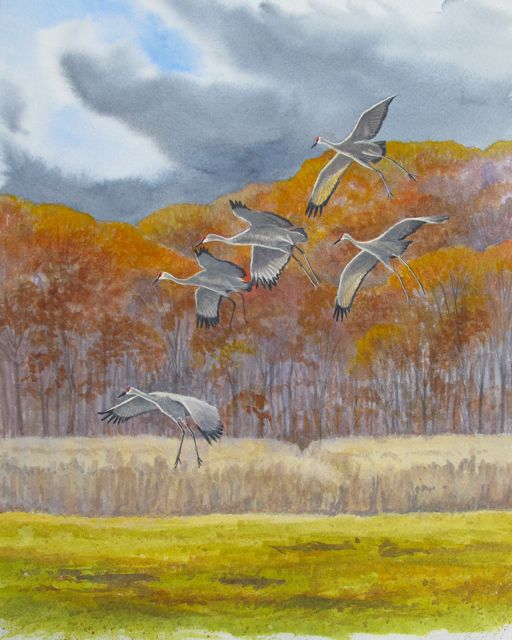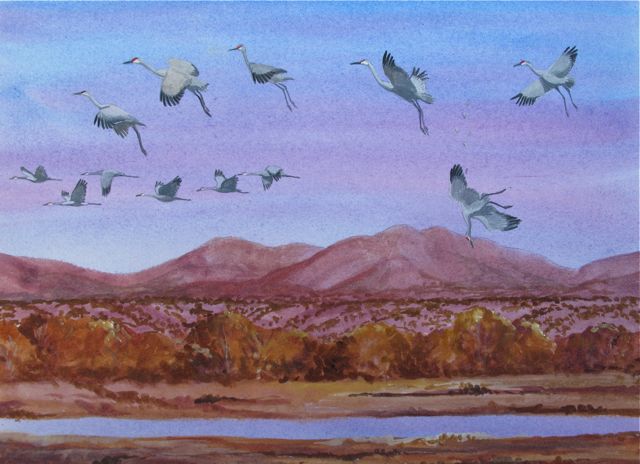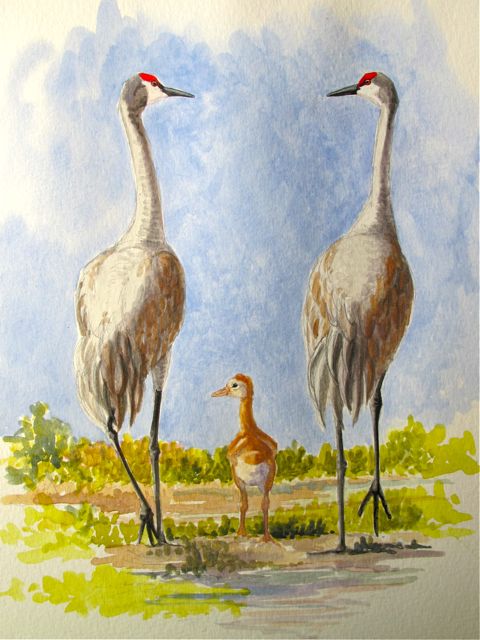Sandhill cranes dropping into a Tennessee field. Watercolor by Julie Zickefoose
When shooting starts on private land around the Hiwassee refuge, Tennessee ornithologists predict that cranes, along with ducks and geese, will make for the refuge. Cranes may be too dumb to divine that the corn managers planted was intended only for ducks and geese, but they are smart enough to avoid places where they’re being fired on. I've seen it suggested that this will actually benefit birders, providing better viewing on the refuge than they'd have were the cranes dispersed on private land. Well, here's something to think about. Concentrating a large population of cranes in a smaller area can result in overcrowding and disease. Birders know that. They want what's best for the birds, not for themselves. I can't imagine any birdwatcher I know saying, "Oh good! They're shooting cranes right outside the refuge! More cranes for ME!!"
What is needed here, it seems, is not more crowding but a natural dispersal of the population, encouraging them to move on south. Now, being a birdwatcher, I admit to being ignorant of the fine points of wildlife management, but what if Tennessee were to taper off the feeding program? Maybe the cranes would keep heading south when the food ran out. Silly, I know, but it’s just crazy enough--it might work. The converse certainly worked.
Tennessee is the first state in the Eastern Flyway to propose a hunting season on sandhill cranes. Kentucky announced its crane hunting season on December 6, 2010. I heard it on the radio as I was writing this post, stopping in mid-tap to stare at the speakers. And oddly, Kentucky isn’t accepting public comment. Have they observed the outcry over Tennessee’s proposal? Memo to Kentucky: Announcing that you’re not accepting public comment doesn’t stop people from calling and writing their legislators.
Oh, and birdwatchers might like to know that Wisconsin’s planning a sandhill crane hunting season, too. Wisconsin: home of the privately funded International Crane Foundation in Baraboo, where the big white whooping crane was snatched back from extinction. Imagine how Wisconsin’s thousands of self-described “craniacs” are going to feel about that. But we mustn’t lead with our hearts. We must accept the wisdom, the necessity of shooting sandhill cranes.
A sandhill crane falls near Bosque del Apache NWR, NM. Watercolor by Julie Zickefoose
The Eastern Flyway sandhill crane population has recovered from near extinction in the last 70 years—in our lifetime--and state game managers have taken notice. Their reasoning appears pretty simple: There are enough cranes around now to shoot some. My reasoning is simple too. Does that mean they must be shot? Is giving a small set of hunters one more bird species to aim at ultimately going to be worth the ill will and polarization of camps between the growing throngs of wildlife watchers and the shrinking ranks of hunters? For the fact-checkers out there: The USFWS estimates that 33 states saw declines in hunting license sales over the last two decades. Massachusetts alone has seen a 50 percent falloff in hunting license sales in that period. Yes, hunting is declining. Maybe if we offer more species that can be shot...
So let's follow this line of reasoning. There are enough cranes out there now to shoot some without causing another population crash. All right then. There are surely enough red-tailed hawks sitting along the nation's highways to shoot some of them. Robins? Those things are everywhere, and tasty, too. And come to think of it, new great blue heron rookeries are popping up all over the place. A little fishy-tasting, but with the right marinade...
Sandhill cranes with their colt. Watercolor by Julie Zickefoose
In my view, the great irony in this whole proposal to hunt cranes is that the majority of people who are aware cranes exist feel exactly as I do, vastly outnumbering those who would like to take a shot at one. Note to Tennessee, Kentucky and Wisconsin: Those cranes you're proposing to shoot are everyone's cranes, not just yours. They may breed in Wisconsin and pass through the southern states, but they belong to everyone, and your proposal to let a small subset of hunters fire on them is not popular with the majority who want them left alone. You are shooting yourself in the foot.
People who believe strongly in their perceived right to hunt whatever they wish can be persuasive in characterizing birders and wildlife watchers as soft-headed and silly for having an emotional connection to birds and animals, for being guided by heart and not head. I believe to my core that it is desirable to hold some species sacred. I feel that way about sandhill cranes because I have observed, from Nebraska to New Mexico, from Michigan to Ohio, that they are potent ambassadors for wild things and wild places to the many thousands of people who are moved by them. These are not necessarily birders, just ordinary people who are stirred by the sight and sound of cranes. Cranes, I submit, are worth infinitely more alive than dead. Just ask the director of the Lillian Annette Rowe Sanctuary on Nebraska's Platte River, where sandhill crane tourism brings 15,000 visitors from all 50 states and 46 foreign countries; brings more than $10 million into the local economy every year. All without firing a single shot. Wildlife watching is the fastest growing sector in tourism.
I'd love to do this experiment. Take 1,000 people who know what a sandhill crane is. What percentage of them do you think would want to bring one down with a gun? What percentage would simply want to watch one fly overhead? We haven't even begun to tap the tourism potential of live Eastern Flyway cranes, and states are already proposing to shoot them?
Tennessee’s Wildlife Resources Agency posted an online survey in mid-November 2010 with a simple question: “Should sandhill cranes be hunted in Tennessee?” Two buttons: Yes and No. The survey was up for perhaps three days, and abruptly taken down without explanation. No results have been posted. In response to questions on “Tennessee’s Watchable Wildlife” Facebook page, the following appeared:
Your best bet to have an impact on the TWRA decision is to contact the TWRA commissioners with letters, phone calls, etc. At some point we'll provide the results of the survey, but keep in mind that it was not a well designed, scientific survey, it was biased in many ways and is not likely a very reliable source of information.
Birders, photographers, wildlife watchers: we don’t need SurveyMonkey to tell Tennessee what we think about opening a season on sandhill cranes. Comments period ends mid-January. A public meeting will be held Jan. 20 and 21 in Nashville, with an opportunity for public comments. Information: Ask.TWRA@tn.gov or 1-800-624-7406.
If you can't attend, please...Write them NOW. For the New Year, do something for the cranes.
Email: twra.comment@tn.gov
Letters: Michael Chase, Tennessee Wildlife Resources Commission Chairperson/PO Box 50370/Knoxville, TN 37950 email: mike.chase@tn.gov
Governor Bill Haslam, 1701 West End Ave., Suite 300, Nashville, TN 37203 (615) 254-4799
online comments to the Governor: https://www.billhaslam.org/suggestions-for-government/




No comments:
Post a Comment